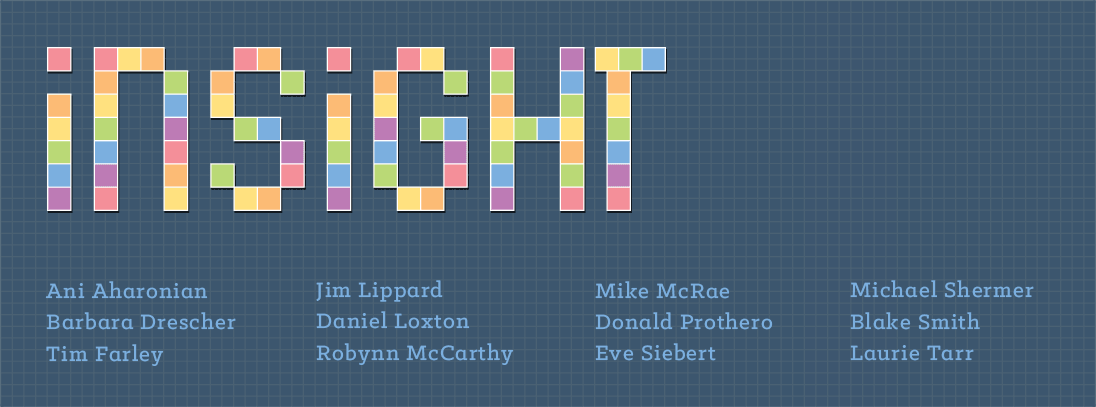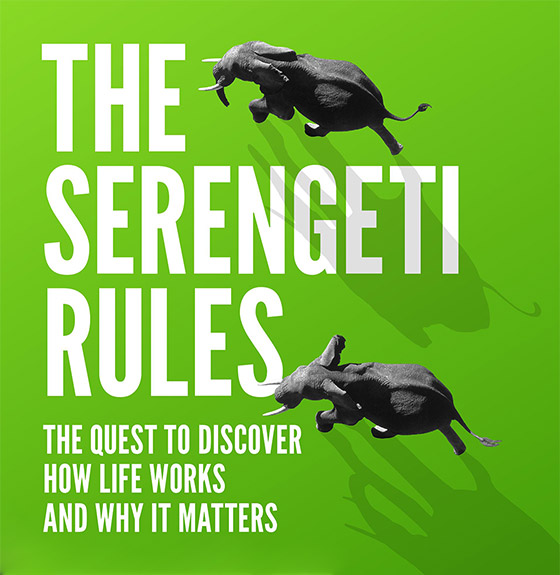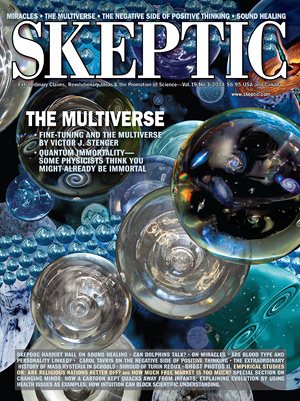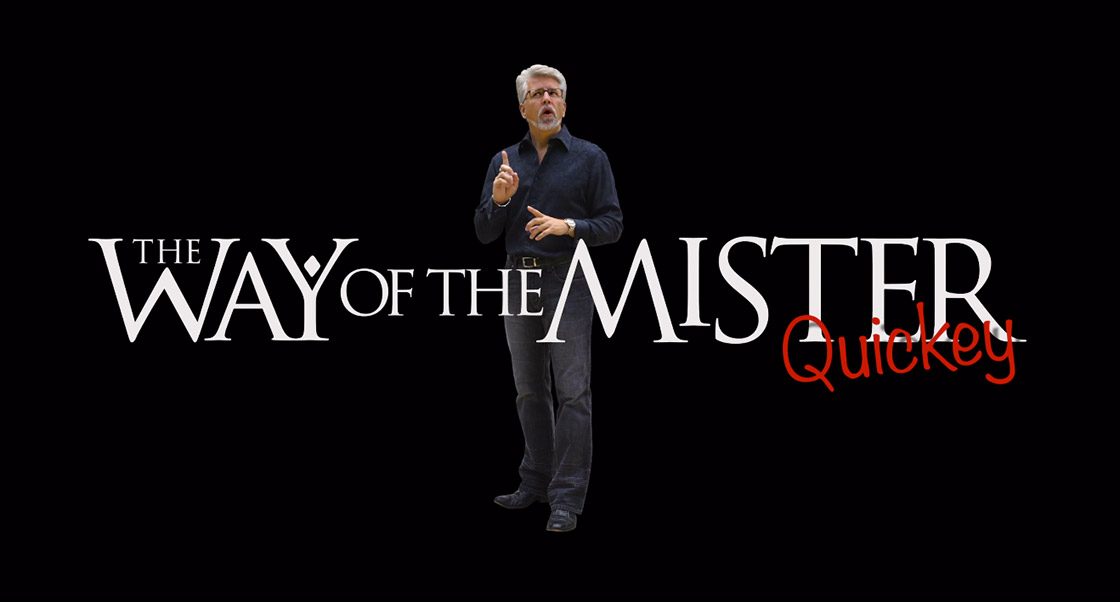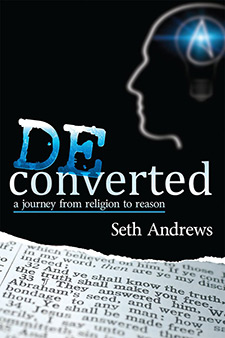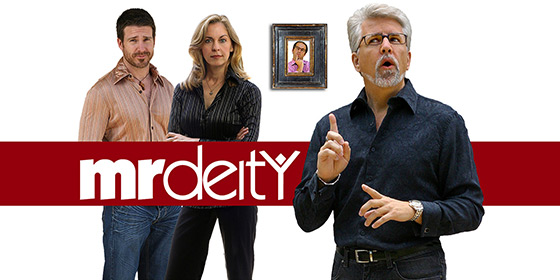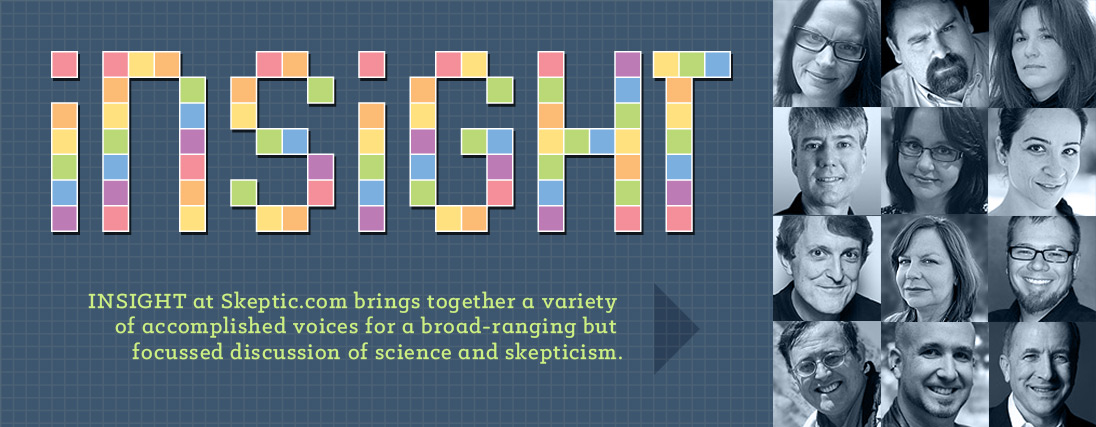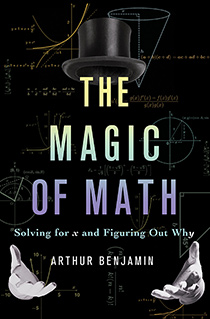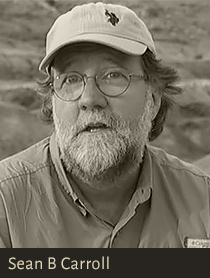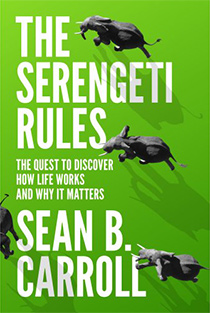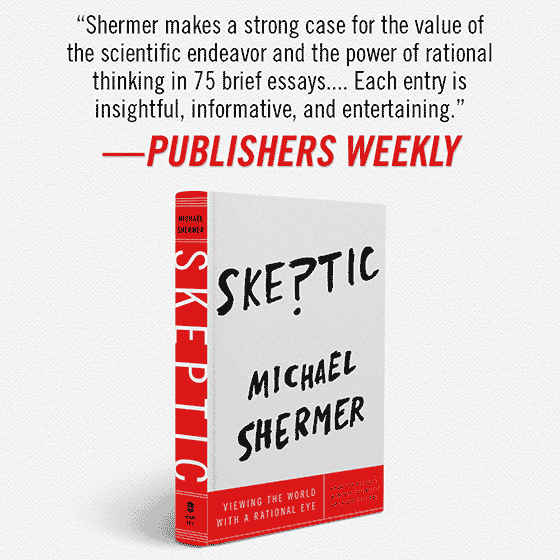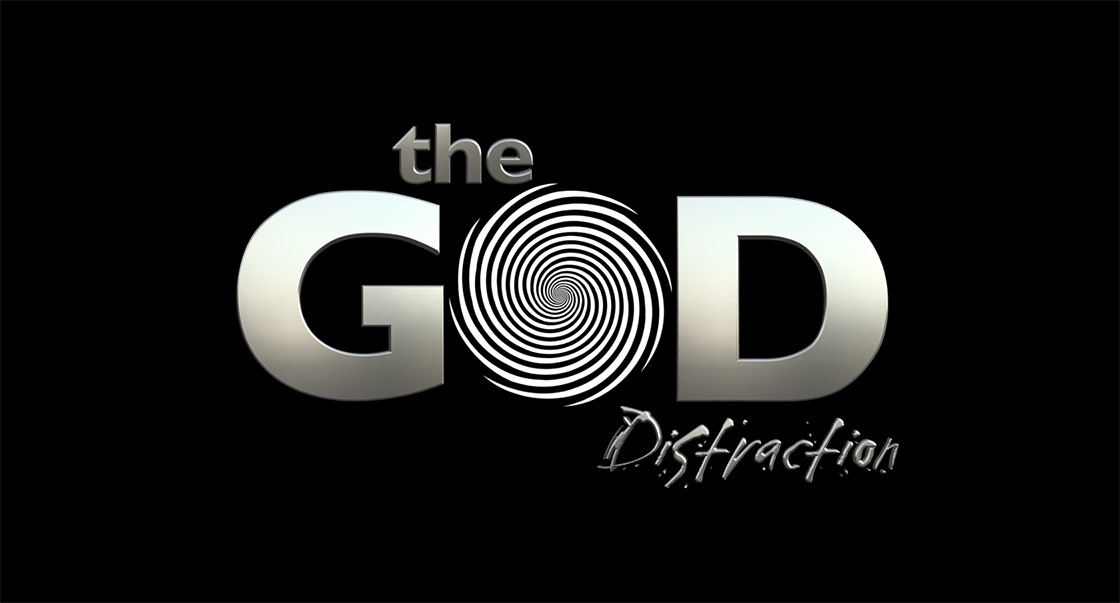eSkeptic for February 24, 2016
In this week’s eSkeptic:
CHAPMAN UNIVERSITY DEBATE MARCH 7
The God vs. Science Smackdown:
Keith Ward vs. Michael Shermer
Noted British author, theologian and philosopher Keith Ward of Oxford University will take on scientist and skeptic Michael Shermer in a debate at Chapman University on the nature of reality, science and religion, and God’s existence. The debate will address such questions as: Can science really explain the origin of the universe, life, consciousness and morality without recourse to God? Or does science in fact provide enough evidence to make belief in God rational?
This epic event, in which one of the world’s leading theists will debate one of the world’s leading atheists, takes place Monday, March 7 at 7:30 p.m. in Chapman University’s Memorial Hall. Chapman chancellor and president-designate Daniele Struppa will moderate the proceedings. The event will be recorded and posted for viewing afterward.
Read about the speakers. Admission is free and open to the public. Get visitor parking information. For more details, call 1-714-997-6636.
About this week’s feature
In this week’s eSkeptic, scientist and historian, Michael Shermer, responds to evolutionary biologist and anthropologist, David Sloan Wilson, about ancient warfare and the notion the blank slate.
Michael Shermer is the Publisher of Skeptic magazine, a monthly columnist for Scientific American, and a Presidential Fellow at Chapman University. He is the author of numerous bestselling books, including The Science of Good and Evil and The Moral Arc: How Science and Reason Lead Humanity Toward Truth, Justice, and Freedom.
On Slates and Tweets: A Reply to David Sloan Wilson on Ancient Warfare and the Blank Slate
by Michael Shermer
On January 21, 2016 I posted a tweet that read:
Sorry blank slaters & Peace & Harmony Mafia: "Evidence of a prehistoric massacre extends the history of warfare." https://t.co/YsAgN2MmFB
— Michael Shermer (@michaelshermer) January 21, 2016
The reference is to those who adhere to the blank slate theory of human nature and those rather aggressive anthropologists who insist that war is a recent invention and that our ancestors lived in relative peace and harmony with one another and nature. The link is to a recent archaeological study that uncovered the fossilized remains of 27 prehistoric hunter-gatherers who were massacred around 10,000 years ago at a place called Nataruk near Lake Turkana in Kenya. Most of the skeletons showed signs of a violent death: blunt-force trauma to the head, broken hands (some of which were bound), shattered knees, cracked ribs and, most revealing, arrowhead projectile points in the skull and thorax and arrow lesions in the neck. The research team, headed by Dr. Marta Mirazon Lahr from Cambridge University, concluded that one band of people was most likely attacked by another band, explaining:
The deaths at Nataruk are testimony to the antiquity of inter-group violence and war. These human remains record the intentional killing of a small band of foragers with no deliberate burial, and provide unique evidence that warfare was part of the repertoire of inter-group relations among some prehistoric hunter-gatherers. […]
SCIENCE SALON MARCH 20
The Serengeti Rules: The Quest to Discover How Life Works and Why It Matters
0
How does life work? How does nature produce the right numbers of zebras and lions on the African savanna, or fish in the ocean? How do our bodies produce the right numbers of cells in our organs and bloodstream? In The Serengeti Rules, award-winning biologist and author Sean B. Carroll tells the stories of the pioneering scientists who sought the answers to such simple yet profoundly important questions, and shows how their discoveries matter for our health and the health of the planet we depend upon.
One of the most important revelations about the natural world is that everything is regulated—there are rules that regulate the amount of every molecule in our bodies and rules that govern the numbers of every animal and plant in the wild. And the most surprising revelation about the rules that regulate life at such different scales is that they are remarkably similar—there is a common underlying logic of life. Carroll recounts how our deep knowledge of the rules and logic of the human body has spurred the advent of revolutionary life-saving medicines, and makes the compelling case that it is now time to use the Serengeti Rules to heal our ailing planet. Order The Serengeti Rules from Amazon.
Call 1-626-794-3119 now to reserve.

HELP SUPPORT OUR EFFORTS
Donate via PayPal and eBay
Did you know that you can support the work of the Skeptics Society by donating to us via PayPal or eBay? You can make a donation to the Skeptics Society via the PayPal Giving Fund, or favourite us on eBay Giving Works, and specify the percentage of your eBay sales that you’d like to donate to us. Your donations directly support the work of your Skeptics Society.
On Slates and Tweets: A Reply to David Sloan Wilson on Ancient Warfare and the Blank Slate
On January 21, 2016 I posted a tweet that read:
Sorry blank slaters & Peace & Harmony Mafia: “Evidence of a prehistoric massacre extends the history of warfare.” https://t.co/YsAgN2MmFB
— Michael Shermer (@michaelshermer) January 21, 2016
The reference is to those who adhere to the blank slate theory of human nature and those rather aggressive anthropologists who insist that war is a recent invention and that our ancestors lived in relative peace and harmony with one another and nature. The link is to a recent archaeological study that uncovered the fossilized remains of 27 prehistoric hunter-gatherers who were massacred around 10,000 years ago at a place called Nataruk near Lake Turkana in Kenya. Most of the skeletons showed signs of a violent death: blunt-force trauma to the head, broken hands (some of which were bound), shattered knees, cracked ribs and, most revealing, arrowhead projectile points in the skull and thorax and arrow lesions in the neck. The research team, headed by Dr. Marta Mirazon Lahr from Cambridge University, concluded that one band of people was most likely attacked by another band, explaining:
The deaths at Nataruk are testimony to the antiquity of inter-group violence and war. These human remains record the intentional killing of a small band of foragers with no deliberate burial, and provide unique evidence that warfare was part of the repertoire of inter-group relations among some prehistoric hunter-gatherers.
It is difficult for archaeologists to interpret motive from fossils, but Lahr suggested:
TAGS: anthropology, archaeology, blank slate, human nature, Lake Turkana, Marta Mirazon Lahr, Nataruk massacre, Niko Tinbergen, tabula rasa, violenceThe Nataruk massacre may have resulted from an attempt to seize resources—territory, women, children, food stored in pots—whose value was similar to those of later food-producing agricultural societies, among whom violent attacks on settlements became part of life. This would extend the history of the same underlying socio-economic conditions that characterise other instances of early warfare: a more settled, materially richer way of life. However, Nataruk may simply be evidence of CONTINUE READING THIS POST…
The Negative Side of Positive Psychology
This article is from Carol Tavris’ column, “The Gadfly,” that appeared in Skeptic magazine 19.3 (2014).
In his book One Simple Idea: How Positive Thinking Reshaped Modern Life, Mitch Horowitz reports with pride how he responded to a task assigned to him by the teacher of a spiritual group. For a winter camping trip, he had to find heart-shaped pink buckets for the female campers who didn’t want to venture into the icy woods at night to urinate. Round wouldn’t do; red wouldn’t do. He searched for days, annoying his wife, who wondered why he didn’t expend the same energy on household tasks. And then, incredibly, he found exactly the right buckets at a neighborhood grocery store. The moral, he says, is that when you “endeavor past all conventional effort, to the point where giving up seems like the only possible option,” you get “an emotional charge that no actuarial table can fully capture.”
Your response to this story will probably predict your response to the positive-thinking movement in general. Are you thinking to yourself, “Talk about bucket lists! What a charming account of positive thinking and persistence in the face of unlikely success!” Or are you thinking, “Did anyone think about the female campers’ reaction to being given a stupid heart-shaped pink bucket? ‘Thanks, Mitch, but I’ll just use my pee shooter so I don’t have to smell a bucket of urine all night or knock it over when I stumble out in the morning.’ How about those household tasks he wasn’t doing—did his wife tell him to, well, piss off?”
Over the years I have grown quite grumpy about positive thinking. I don’t object to it as a general life strategy, of course; but the oversimplified litany of alleged benefits it produces is scientifically problematic. Over the years of constantly updating an introductory psychology textbook with my coauthor Carole Wade, new research obliges us to keep whittling away our previous discussions of positive psychology’s benefits. In our latest edition, positive psychology is barely a shadow of its former hulking self.
Let’s start with optimism. When something bad happens to you, it certainly seems logical that it is healthier to assume that you will come through it okay than to gloomily mutter, “I knew it. The whole world is against me, including Minneapolis and Tasmania.” In a fundamental way, optimism in the face of occasional setbacks makes life possible. If people are going through a rough patch but believe things will get better eventually, they are more likely to CONTINUE READING THIS POST…
TAGS: optimism, positive thinking, psychology, scienceeSkeptic for February 17, 2016
In this week’s eSkeptic:
SCIENCE SALON MARCH 20
The Serengeti Rules: The Quest to Discover How Life Works and Why It Matters
9
How does life work? How does nature produce the right numbers of zebras and lions on the African savanna, or fish in the ocean? How do our bodies produce the right numbers of cells in our organs and bloodstream? In The Serengeti Rules, award-winning biologist and author Sean B. Carroll tells the stories of the pioneering scientists who sought the answers to such simple yet profoundly important questions, and shows how their discoveries matter for our health and the health of the planet we depend upon.
One of the most important revelations about the natural world is that everything is regulated—there are rules that regulate the amount of every molecule in our bodies and rules that govern the numbers of every animal and plant in the wild. And the most surprising revelation about the rules that regulate life at such different scales is that they are remarkably similar—there is a common underlying logic of life. Carroll recounts how our deep knowledge of the rules and logic of the human body has spurred the advent of revolutionary life-saving medicines, and makes the compelling case that it is now time to use the Serengeti Rules to heal our ailing planet. Order The Serengeti Rules from Amazon.
Call 1-626-794-3119 now to reserve.

Bad Clowns
SKEPTICALITY EPISODE 267
In this episode of Skepticality, Derek chats with author, investigator, and past guest on the show, Ben Radford, about his latest book: Bad Clowns. Clowns might not make the list of usual skeptical topics, but Ben thinks you might just change your mind once you delve into the history and stories in his new work. So, turn off the lights, snuggle your favorite creepy clown, and join in for some bad clown fun!
About this week’s feature
The oversimplified litany of alleged benefits of positive thinking is scientifically problematic. New research keeps whittling away at previously discussions of the benefits of positive psychology such that it is barely a shadow of its former hulking self. In this week’s eSkeptic, we present Carol Tavris’ column, “The Gadfly,” from Skeptic magazine 19.3 (2014) in which she examines the negative side of positive psychology.
Dr. Carol Tavris is a social psychologist and coauthor, with Elliot Aronson, of Mistakes were made (but not by ME). Order the book or the lecture on DVD.
The Negative Side of Positive Psychology
by Carol Tavris
In his book One Simple Idea: How Positive Thinking Reshaped Modern Life, Mitch Horowitz reports with pride how he responded to a task assigned to him by the teacher of a spiritual group. For a winter camping trip, he had to find heart-shaped pink buckets for the female campers who didn’t want to venture into the icy woods at night to urinate. Round wouldn’t do; red wouldn’t do. He searched for days, annoying his wife, who wondered why he didn’t expend the same energy on household tasks. And then, incredibly, he found exactly the right buckets at a neighborhood grocery store. The moral, he says, is that when you “endeavor past all conventional effort, to the point where giving up seems like the only possible option,” you get “an emotional charge that no actuarial table can fully capture.”
Your response to this story will probably predict your response to the positive-thinking movement in general. Are you thinking to yourself, “Talk about bucket lists! What a charming account of positive thinking and persistence in the face of unlikely success!” Or are you thinking, “Did anyone think about the female campers’ reaction to being given a stupid heart-shaped pink bucket? ‘Thanks, Mitch, but I’ll just use my pee shooter so I don’t have to smell a bucket of urine all night or knock it over when I stumble out in the morning.’ How about those household tasks he wasn’t doing—did his wife tell him to, well, piss off?”
Over the years I have grown quite grumpy about positive thinking. I don’t object to it as a general life strategy, of course; but the oversimplified litany of alleged benefits it produces is scientifically problematic. Over the years of constantly updating an introductory psychology textbook with my coauthor Carole Wade, new research obliges us to keep whittling away our previous discussions of positive psychology’s benefits. In our latest edition, positive psychology is barely a shadow of its former hulking self. […]

HELP SUPPORT OUR EFFORTS
Donate via PayPal and eBay
Did you know that you can support the work of the Skeptics Society by donating to us via PayPal or eBay? You can make a donation to the Skeptics Society via the PayPal Giving Fund, or favourite us on eBay Giving Works, and specify the percentage of your eBay sales that you’d like to donate to us. Your donations directly support the work of your Skeptics Society.
Science Based Medicine
The James Randi Educational Foundation has produced a superb 10-part video lecture series in which Harriet Hall, M.D., contrasts science-based medicine with so-called “complementary and alternative” methods. The topics include: What is CAM?; acupuncture; chiropractic; energy medicine; homeopathy; miscellaneous “alternatives”; naturopathy and herbal medicines; pitfalls in research; science based medicine vs. evidence-based medicine; science-based medicine in the media and politics. The lectures range from 32 to 45 minutes. A companion course guide is also available. Listen to the audio advertisement for the course. Listen to the audio advertisement for the course.
Watch the 10-part video series
eSkeptic for February 10, 2016
In this week’s eSkeptic:
NEW INTERVIEW VIDEO
Michael Shermer on His Own Beliefs About, and Experiences with, the “Supernatural”
About the Book
For fifteen years, bestselling author Michael Shermer has written a column in Scientific American magazine that synthesizes scientific concepts and theory for a general audience. His trademark combination of deep scientific understanding and entertaining writing style has thrilled his huge and devoted audience for years. Now, in SKE?TIC, seventy-five of these columns are available together for the first time; a welcome addition for his fans and a stimulating introduction for new readers.

About this week’s feature
Most Americans continue to grow up without thinking very deeply about other religions (other than mocking them on a superficial basis), and never question the assumptions of their own faith. In this week’s eSkeptic, Donald Prothero reviews Sacred Cows: A Lighthearted Look at Belief and Tradition Around the World, by Seth Andrews, in which he does all that, and more.
All Sacred Cows
by Donald Prothero
Those of us who have read extensively in the field of comparative religion are pretty familiar with many of the bizarre beliefs and practices of religions and cultures all over the world. But most Americans are alarmingly insular and unaware of other cultures and religions, especially if they’ve been raised in a small rural town and taught to think only one way by their church. Even in the relatively liberal Presbyterian church where I was raised, serious discussions of other religions were taboo. It was not until high school church groups that I heard about other “cult” religions such as Jehovah’s Witnesses, Mormons, Christian Scientists, and Scientologists, and that exposure was simply to mock and condemn their belief systems, without any close examination of the absurdities we were expected to believe. Most Americans continue to grow up without thinking very deeply about other religions (other than mocking them on a superficial basis), and never question the assumptions of their own faith.
Seth Andrews came from such a background. Raised in a strict fundamentalist church and sheltered from exposure to any ideas about religion or science that might shake his faith, he went through life without questioning any of it until he was an adult. As he recounts in his previous autobiographical book Deconverted: A Journey from Religion to Reason (which I reviewed), Andrews was making a living as a DJ on a Christian rock station, still deeply in the faith and insulated from doubt, until a series of events (deaths of beloved Christian rock musicians, 9/11, and switching to a secular radio station) opened his eyes and changed his perspective. Now he runs the very successful Thinking Atheist podcast and produces a number of outstanding videos for YouTube. Thus, Andrews comes to the study of comparative religions and cultures as a layman, rather than a scholar, with a background much like the rest of the fundamentalists in this country who are so vocal about pushing creationism in our schools and affecting our political process. […]
NEW EPISODE
The Way of the Mister (Quickey): Breaking Up With Richard Dawkins
Twitter cometh before the fall?
FOLLOW MR. DEITY
DONATE • PATREON • FACEBOOK • VIMEO • MRDEITY.COM
All Sacred Cows
Those of us who have read extensively in the field of comparative religion are pretty familiar with many of the bizarre beliefs and practices of religions and cultures all over the world. But most Americans are alarmingly insular and unaware of other cultures and religions, especially if they’ve been raised in a small rural town and taught to think only one way by their church. Even in the relatively liberal Presbyterian church where I was raised, serious discussions of other religions were taboo. It was not until high school church groups that I heard about other “cult” religions such as Jehovah’s Witnesses, Mormons, Christian Scientists, and Scientologists, and that exposure was simply to mock and condemn their belief systems, without any close examination of the absurdities we were expected to believe. Most Americans continue to grow up without thinking very deeply about other religions (other than mocking them on a superficial basis), and never question the assumptions of their own faith.
Seth Andrews came from such a background. Raised in a strict fundamentalist church and sheltered from exposure to any ideas about religion or science that might shake his faith, he went through life without questioning any of it until he was an adult. As he recounts in his previous autobiographical book Deconverted: A Journey from Religion to Reason (which I reviewed), Andrews was making a living as a DJ on a Christian rock station, still deeply in the faith and insulated from doubt, until a series of events (deaths of beloved Christian rock musicians, 9/11, and switching to a secular radio station) opened his eyes and changed his perspective. Now he runs the very successful Thinking Atheist podcast and produces a number of outstanding videos for YouTube. Thus, Andrews comes to the study of comparative religions and cultures as a layman, rather than a scholar, with a background much like the rest of the fundamentalists in this country who are so CONTINUE READING THIS POST…
TAGS: beliefs, comparative religion, cults, culture, revieweSkeptic for February 3, 2016
In this week’s eSkeptic:
NEW INTERVIEW VIDEO
Michael Shermer on the Most Dangerous Pseudoscientific Beliefs that People Hold
About the Book
For fifteen years, bestselling author Michael Shermer has written a column in Scientific American magazine that synthesizes scientific concepts and theory for a general audience. His trademark combination of deep scientific understanding and entertaining writing style has thrilled his huge and devoted audience for years. Now, in SKE?TIC, seventy-five of these columns are available together for the first time; a welcome addition for his fans and a stimulating introduction for new readers.
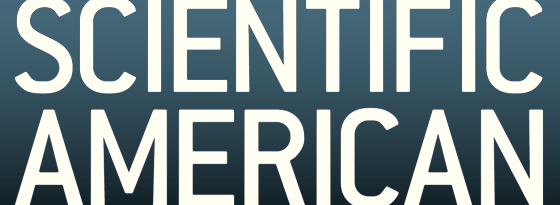
NEW SCIENTIFIC AMERICAN COLUMN ON MICHAELSHERMER.COM
Afterlife for Atheists: Can a Brain’s Connectome be Preserved Forever?
The soul is the pattern of information that represents you—your thoughts, memories and personality—your self. There is no scientific evidence that something like soul stuff exists beyond the brain’s own hardwiring, so I was curious to visit the laboratories of 21st Century Medicine in Fontana, Calif., to see for myself an attempt to preserve a brain’s connectome—the comprehensive diagram of all neural synaptic connections.
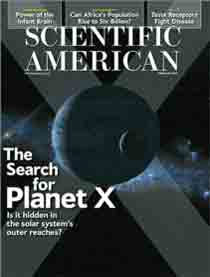
This medical research company specializes in the cryopreservation of human organs and tissues using cryoprotectants (antifreeze). In 2009, for example, the facility’s chief research scientist Gregory M. Fahy published a paper in the peer-reviewed journal Organogenesis, documenting how his team successfully transplanted a rewarmed rabbit kidney after it had been cryoprotected and frozen to -135 degrees Celsius through the process of vitrification, “in which the liquids in a living system are converted into the glassy state at low temperatures.”
Can brains be so preserved? Fahy and his colleague Robert L. McIntyre are now developing techniques that they hope will win the Brain Preservation Technology Prize, the brainchild of neuroscientist Kenneth Hayworth (I’m on their advisory board as the advocatus diaboli). As I write this, the prize is currently valued at more than $106,000; the first 25 percent of the award will be for the complete preservation of the synaptic structure of a whole mouse brain, and the other 75 percent will go to the first team “to successfully preserve a whole large animal brain in a manner that could also be adopted for humans in a hospital or hospice setting immediately upon clinical death.” […]
FOLLOW MICHAEL SHERMER ON
Twitter • Facebook • Insight • The Moral Arc Blog
About this week’s feature
In this week’s eSkeptic, Harriet Hall, M.D. (a.k.a. The SkepDoc) takes a close look at Samir Chachoua, a man who claims to have discovered a cure for HIV/AIDS, cancer, and a host of other illnesses.
Be sure to check out Harriet Hall’s free, ten part, video lecture series, entitled Science Based Medicine. More details below.
Charlie Sheen’s HIV Goat Milk Doctor
by Harriet Hall, M.D.
On January 29, 2016, HBO Real Time host Bill Maher featured Samir Chachoua, a man who claims to have discovered a cure for HIV/AIDS, cancer, and a host of other illnesses. He is not licensed to practice medicine in the US; he operates out of Mexico where he charges rich visitors many thousands of dollars for treatment with his untested vaccines. Most of what he says on the program is unverifiable, demonstrably false, or frankly impossible.
Charlie Sheen: Failure, not a Success
The problem from the start is that Chachoua claims to have cured Charlie Sheen of HIV, and yet he admits that Charlie still has HIV. What gives? He says Charlie was dying from severe encephalitis, was incontinent, couldn’t tolerate daylight, and had severe liver failure. He claims to have “fixed” the liver, eliminated all the symptoms, and returned Charlie to vibrant health within a few hours of the first treatment. He claims that “within minutes” of starting his therapy, Charlie’s liver tests went to normal levels. That is simply not a believable claim, and no proof is on the offing. Damaged tissue takes time to heal. Recovery from chronic illness takes more than a matter of hours.
Charlie Sheen was also featured on a recent episode of Dr. Oz. There he described how Chachoua injected himself with Charlie’s blood. Bizarrely, he drew blood from some kind of lump on Charlie’s elbow rather than from a vein. Dr. Oz was appalled, as anyone would be. Not only was there a risk of HIV transmission, but there was a risk of transfusion reaction from mismatched blood that had not been typed and cross-matched. If the incident really occurred, it was nothing but a theatrical stunt demonstrating Chachoua’s overconfidence and poor judgment.
Sheen had been on antiretroviral medications that had reduced his viral load to undetectable levels. As with all such patients, this does not mean the virus had been eradicated from the entire body. When Sheen stopped taking the meds, the HIV titers (concentrations) remained undetectable for a while, but then started going back up, exactly as would be expected. Chachoua started treating him during the undetectable period and proclaimed Charlie cured. But then Charlie’s titers started rising again. He realized he was not cured and went right back on his antiretroviral medications on the plane home from Mexico.
FREE COURSE BY HARRIET HALL, M.D.
Science Based Medicine
The James Randi Educational Foundation has produced a superb 10-part video lecture series in which Harriet Hall, M.D., contrasts science-based medicine with so-called “complementary and alternative” methods. The topics include: What is CAM?; acupuncture; chiropractic; energy medicine; homeopathy; miscellaneous “alternatives”; naturopathy and herbal medicines; pitfalls in research; science based medicine vs. evidence-based medicine; science-based medicine in the media and politics. The lectures range from 32 to 45 minutes. A companion course guide is also available. Listen to the audio advertisement for the course.
NEW EPISODE
Mr. Deity and The Apologist
In this episode, Mr. Deity tells Lucy how excited he is about one of Allah’s new apologists.
FOLLOW MR. DEITY
DONATE • PATREON • FACEBOOK • VIMEO • MRDEITY.COM
SCIENCE SALON MARCH 20
The Serengeti Rules: The Quest to Discover How Life Works and Why It Matters
How does life work? How does nature produce the right numbers of zebras and lions on the African savanna, or fish in the ocean? How do our bodies produce the right numbers of cells in our organs and bloodstream? In The Serengeti Rules, award-winning biologist and author Sean B. Carroll tells the stories of the pioneering scientists who sought the answers to such simple yet profoundly important questions, and shows how their discoveries matter for our health and the health of the planet we depend upon.
One of the most important revelations about the natural world is that everything is regulated—there are rules that regulate the amount of every molecule in our bodies and rules that govern the numbers of every animal and plant in the wild. And the most surprising revelation about the rules that regulate life at such different scales is that they are remarkably similar—there is a common underlying logic of life. Carroll recounts how our deep knowledge of the rules and logic of the human body has spurred the advent of revolutionary life-saving medicines, and makes the compelling case that it is now time to use the Serengeti Rules to heal our ailing planet. Order The Serengeti Rules from Amazon.
Call 1-626-794-3119 now to reserve.
Charlie Sheen’s HIV Goat Milk Doctor
On January 29, 2016, HBO Real Time host Bill Maher featured Samir Chachoua, a man who claims to have discovered a cure for HIV/AIDS, cancer, and a host of other illnesses. He is not licensed to practice medicine in the US; he operates out of Mexico where he charges rich visitors many thousands of dollars for treatment with his untested vaccines. Most of what he says on the program is unverifiable, demonstrably false, or frankly impossible.
Charlie Sheen: Failure, not a Success
The problem from the start is that Chachoua claims to have cured Charlie Sheen of HIV, and yet he admits that Charlie still has HIV. What gives? He says Charlie was dying from severe encephalitis, was incontinent, couldn’t tolerate daylight, and had severe liver failure. He claims to have “fixed” the liver, eliminated all the symptoms, and returned Charlie to vibrant health within a few hours of the first treatment. He claims that “within minutes” of starting his therapy, Charlie’s liver tests went to normal levels. That is simply not a believable claim, and no proof is on the offing. Damaged tissue takes time to heal. Recovery from chronic illness takes more than a matter of hours.
Charlie Sheen was also featured on a recent episode of Dr. Oz. There he described how Chachoua injected himself with Charlie’s blood. Bizarrely, he drew blood from some kind of lump on Charlie’s elbow rather than from a vein. Dr. Oz was appalled, as anyone would be. Not only was there a risk of HIV transmission, but there was a risk of transfusion reaction from mismatched blood that had not been typed and cross-matched. If the incident really occurred, it was CONTINUE READING THIS POST…
TAGS: AIDS, alternative medicine, Charlie Sheen, HIV, pseudoscience, Samir ChachouaeSkeptic for January 27, 2016
In this week’s eSkeptic:
SCIENCE SALON MARCH 20
The Serengeti Rules: The Quest to Discover How Life Works and Why It Matters
How does life work? How does nature produce the right numbers of zebras and lions on the African savanna, or fish in the ocean? How do our bodies produce the right numbers of cells in our organs and bloodstream? In The Serengeti Rules, award-winning biologist and author Sean B. Carroll tells the stories of the pioneering scientists who sought the answers to such simple yet profoundly important questions, and shows how their discoveries matter for our health and the health of the planet we depend upon.
One of the most important revelations about the natural world is that everything is regulated—there are rules that regulate the amount of every molecule in our bodies and rules that govern the numbers of every animal and plant in the wild. And the most surprising revelation about the rules that regulate life at such different scales is that they are remarkably similar—there is a common underlying logic of life. Carroll recounts how our deep knowledge of the rules and logic of the human body has spurred the advent of revolutionary life-saving medicines, and makes the compelling case that it is now time to use the Serengeti Rules to heal our ailing planet. Order The Serengeti Rules from Amazon.
Call 1-626-794-3119 now to reserve.
NEW INTERVIEW VIDEO
Michael Shermer on His Favorite Topics to Write About in Scientific American
About the Book
For fifteen years, bestselling author Michael Shermer has written a column in Scientific American magazine that synthesizes scientific concepts and theory for a general audience. His trademark combination of deep scientific understanding and entertaining writing style has thrilled his huge and devoted audience for years. Now, in SKE?TIC, seventy-five of these columns are available together for the first time; a welcome addition for his fans and a stimulating introduction for new readers.

An artist’s concept depicts an orbiting swarm of dusty comet fragments as a possible explanation for the unusual light signal of KIC 8462852. (by NASA/JPL-Caltech [Public domain], via Wikimedia Commons)
About this week’s feature
It’s possible that life exists outside of our solar system and that we may, one day, find it. The Internet has been abuzz with speculation that an alien megastructure orbiting the star KIC 8462852 is responsible for the star’s erratic flicker. Since scientists have yet to advance a convincing natural explanation, attention has turned to more tantalizing possibilities. In this week’s eSkeptic, Dr. George Michael discusses a number of theories that have been advanced to explain the anomalous activity of the star.
The Great ET Paradox: Why We are Likely to Find Them Before They Find Us
by George Michael
Despite over 50 years of effort, the Search for Extraterrestrial Intelligence (SETI) enterprise has yet to detect any telltale signs of sentient life beyond Earth. But exciting news of an anomalous star 1,400 light-years from Earth has raised new hopes that we are not alone in the galaxy after all. Using data collected by the Kepler space telescope, astronomers discovered that the distant star—KIC 8462852—flickers in an unusual way, as if some unknown celestial bodies were intermittently obscuring it. Of the roughly 150,000 stars within view of the Kepler telescope, KIC 8462852 is the only one that glimmers in this odd fashion.1 Since it has been observed over the past few years, KIC 8462852 has dimmed dramatically, at times dropping in brightness as much as 22 percent.2 Moreover, the recorded dips have not been regular, but uneven and unpredictable. Tabetha Boyajian announced these amazing findings that she and members of Planet Hunters—a citizen science program launched at Yale University—in a paper recently published in the Monthly Notices of the Royal Astronomical Society.3
A number of theories have been advanced to explain the anomalous activity of the star. Conceivably, the dips in light could be occasioned by an orbiting a planet, but even a Jupiter-sized planet would only dim this type of star by only 1 percent as it transited across. Furthermore, the irregular flickering associated with the star would not be consistent with a planet making a regular orbit, which would produce predictable dimming. Perhaps fragments from a planetary collision could be responsible for the dimming light, but such events are so rare that we would not expect Kepler to pick up such activity based on probabilities.4 Finally, the star could be surrounded by an accretion disk of dust and rubble that has not yet agglomerated into planets or been gobbled up by the star itself. Such an explanation would be convincing if the star was young, but KIC 8462852 appears to be mature. As Jason Wright, a professor of astronomy at Penn State University, noted, the star is moving too fast to have formed recently, as it fails to show any infrared signs of a big disk that would normally be associated with the material that could cause such dips in brightness.5
Because scientists have yet to advance a convincing natural explanation, attention has turned to more tantalizing possibilities. By far the most exciting is that an alien megastructure is responsible for blocking the light emitted by the star.6 After news of the star’s unusual features was released, SETI scientists quickly began using the Allen Telescope Array in California to examine radio emissions from the area of star for any signs of artificiality.
The Great ET Paradox: Why We are Likely to Find Them Before They Find Us
Despite over 50 years of effort, the Search for Extraterrestrial Intelligence (SETI) enterprise has yet to detect any telltale signs of sentient life beyond Earth. But exciting news of an anomalous star 1,400 light-years from Earth has raised new hopes that we are not alone in the galaxy after all. Using data collected by the Kepler space telescope, astronomers discovered that the distant star—KIC 8462852—flickers in an unusual way, as if some unknown celestial bodies were intermittently obscuring it. Of the roughly 150,000 stars within view of the Kepler telescope, KIC 8462852 is the only one that glimmers in this odd fashion.1 Since it has been observed over the past few years, KIC 8462852 has dimmed dramatically, at times dropping in brightness as much as 22 percent.2 Moreover, the recorded dips have not been regular, but uneven and unpredictable. Tabetha Boyajian announced these amazing findings that she and members of Planet Hunters—a citizen science program launched at Yale University—in a paper recently published in the Monthly Notices of the Royal Astronomical Society.3
A number of theories have been advanced to explain the anomalous activity of the star. Conceivably, the dips in light could be occasioned by an orbiting a planet, but even a Jupiter-sized planet would only dim this type of star by only 1 percent as it transited across. Furthermore, the irregular flickering associated with the star would not be consistent with a planet making a regular orbit, which would produce predictable dimming. Perhaps fragments from a planetary collision could be responsible for the dimming light, but such events are so rare that we would not expect Kepler to pick up such activity based on probabilities.4 Finally, the star could be surrounded by an accretion disk of dust and rubble that has not yet agglomerated into planets or been gobbled up by the star itself. Such an explanation would be convincing if the star was young, but KIC 8462852 appears to be mature. As Jason Wright, a professor of astronomy at Penn State University, noted, the star is moving too fast to have CONTINUE READING THIS POST…
TAGS: alien megastructure, aliens, KIC 8462852Dr. Arthur Benjamin — The Magic of Math: Solving for x and Figuring Out Why
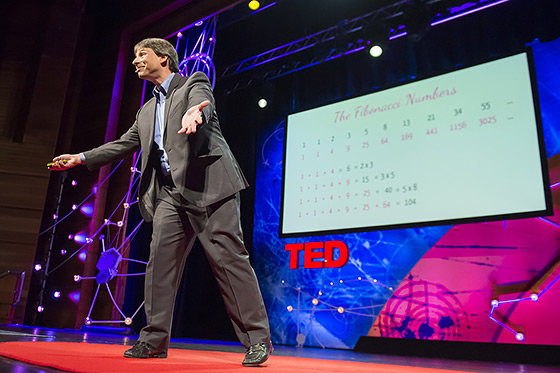
Arthur Benjamin (TED Global)
The Magic of Math is the math book you wish you had in school. Using a delightful assortment of examples—from ice cream scoops and poker hands to measuring mountains and making magic squares—this book empowers you to see the beauty, simplicity, and truly magical properties behind those formulas and equations that once left your head spinning. You’ll learn the key ideas of classic areas of mathematics like arithmetic, algebra, geometry, trigonometry, and calculus, but you’ll also have fun fooling around with Fibonacci numbers, investigating infinity, and marveling over mathematical magic tricks that will make you look like a math genius!
A mathematician who is known throughout the world as the “mathemagician,” Arthur Benjamin mixes mathematics and magic to make the subject fun, attractive, and easy to understand. In The Magic of Math, Benjamin does more than just teach skills: with a tip of his magic hat, he takes you on as his apprentice to teach you how to appreciate math the way he does. He motivates you to learn something new about how to solve for x, because there is real pleasure to be found in the solution to a challenging problem or in using numbers to do something useful. But what he really wants you to do is be able to figure out why, for that’s where you’ll find the real beauty, power, and magic of math.
If you are already someone who likes math, this Science Salon will dazzle and amuse you. If you never particularly liked or understood math, Benjamin will enlighten you and—with a wave of his magic wand—turn you into a math lover.
Order The Magic of Math from Shop Skeptic. We will also have Benjamin’s The Great Courses, including The Joy of Math, Discrete Mathematics, The Secrets of Mental Math, and Mathematics of Games and Puzzles, available for purchase at the event.
TAGS: mathemagics, Science Salon, The Michael Shermer ShoweSkeptic for January 20, 2016
In this week’s eSkeptic:

SCIENCE SALON THIS SUNDAY JAN. 24
The Magic of Math: Solving for x and Figuring Out Why
The Magic of Math is the math book you wish you had in school. Using a delightful assortment of examples—from ice cream scoops and poker hands to measuring mountains and making magic squares—this book empowers you to see the beauty, simplicity, and truly magical properties behind those formulas and equations that once left your head spinning. You’ll learn the key ideas of classic areas of mathematics like arithmetic, algebra, geometry, trigonometry, and calculus, but you’ll also have fun fooling around with Fibonacci numbers, investigating infinity, and marveling over mathematical magic tricks that will make you look like a math genius!
A mathematician who is known throughout the world as the “mathemagician,” Arthur Benjamin mixes mathematics and magic to make the subject fun, attractive, and easy to understand. In The Magic of Math, Benjamin does more than just teach skills: with a tip of his magic hat, he takes you on as his apprentice to teach you how to appreciate math the way he does. He motivates you to learn something new about how to solve for x, because there is real pleasure to be found in the solution to a challenging problem or in using numbers to do something useful. But what he really wants you to do is be able to figure out why, for that’s where you’ll find the real beauty, power, and magic of math.
If you are already someone who likes math, this Science Salon will dazzle and amuse you. If you never particularly liked or understood math, Benjamin will enlighten you and—with a wave of his magic wand—turn you into a math lover.
Order The Magic of Math from Amazon. We will also have Benjamin’s The Great Courses, including The Joy of Math, Discrete Mathematics, The Secrets of Mental Math, and Mathematics of Games and Puzzles, available for purchase at the event.
Call 1-626-794-3119 now to reserve.
NEW INTERVIEW VIDEO
Michael Shermer Discusses What Inspired Him To Write Science for General Audiences
About the Book
For fifteen years, bestselling author Michael Shermer has written a column in Scientific American magazine that synthesizes scientific concepts and theory for a general audience. His trademark combination of deep scientific understanding and entertaining writing style has thrilled his huge and devoted audience for years. Now, in SKE?TIC, seventy-five of these columns are available together for the first time; a welcome addition for his fans and a stimulating introduction for new readers.


Breakfast Cereal Skepticism
SKEPTICALITY EPISODE 266
In this episode of Skepticality, Derek has a conversation with Zack Wienersmith, the creator/author of the popular web comic series Saturday Morning Breakfast Cereal (SMBC). Zach was a speaker at The Amazing Meeting 13. So, while they were both in the same bulding, Derek was able to get some time with Zack to discuss how he got interested in science, skeptical thinking, and how the two relate … or not.
eSkeptic for January 13, 2016
In this week’s eSkeptic:
UPCOMING SCIENCE SALONS
The Magic of Math: Solving for x and Figuring Out Why
The Magic of Math is the math book you wish you had in school. Using a delightful assortment of examples—from ice cream scoops and poker hands to measuring mountains and making magic squares—this book empowers you to see the beauty, simplicity, and truly magical properties behind those formulas and equations that once left your head spinning. You’ll learn the key ideas of classic areas of mathematics like arithmetic, algebra, geometry, trigonometry, and calculus, but you’ll also have fun fooling around with Fibonacci numbers, investigating infinity, and marveling over mathematical magic tricks that will make you look like a math genius!
A mathematician who is known throughout the world as the “mathemagician,” Arthur Benjamin mixes mathematics and magic to make the subject fun, attractive, and easy to understand. In The Magic of Math, Benjamin does more than just teach skills: with a tip of his magic hat, he takes you on as his apprentice to teach you how to appreciate math the way he does. He motivates you to learn something new about how to solve for x, because there is real pleasure to be found in the solution to a challenging problem or in using numbers to do something useful. But what he really wants you to do is be able to figure out why, for that’s where you’ll find the real beauty, power, and magic of math.
If you are already someone who likes math, this Science Salon will dazzle and amuse you. If you never particularly liked or understood math, Benjamin will enlighten you and—with a wave of his magic wand—turn you into a math lover.
Order The Magic of Math from Amazon. We will also have Benjamin’s The Great Courses, including The Joy of Math, Discrete Mathematics, The Secrets of Mental Math, and Mathematics of Games and Puzzles, available for purchase at the event.
Call the Skeptics Society office now to reserve: 1-626-794-3119.
The Serengeti Rules: The Quest to Discover How Life Works and Why It Matters
How does life work? How does nature produce the right numbers of zebras and lions on the African savanna, or fish in the ocean? How do our bodies produce the right numbers of cells in our organs and bloodstream? In The Serengeti Rules, award-winning biologist and author Sean Carroll tells the stories of the pioneering scientists who sought the answers to such simple yet profoundly important questions, and shows how their discoveries matter for our health and the health of the planet we depend upon.
One of the most important revelations about the natural world is that everything is regulated—there are rules that regulate the amount of every molecule in our bodies and rules that govern the numbers of every animal and plant in the wild. And the most surprising revelation about the rules that regulate life at such different scales is that they are remarkably similar—there is a common underlying logic of life. Carroll recounts how our deep knowledge of the rules and logic of the human body has spurred the advent of revolutionary life-saving medicines, and makes the compelling case that it is now time to use the Serengeti Rules to heal our ailing planet. Order The Serengeti Rules from Amazon.
Call the Skeptics Society office now to reserve: 1-626-794-3119.
NEW BOOK AVAILABLE NOW!
Collected essays from bestselling author Michael Shermer’s celebrated columns in Scientific American
For fifteen years, bestselling author Michael Shermer has written a column in Scientific American magazine that synthesizes scientific concepts and theory for a general audience. His trademark combination of deep scientific understanding and entertaining writing style has thrilled his huge and devoted audience for years. Now, in SKE?TIC, seventy-five of these columns are available together for the first time; a welcome addition for his fans and a stimulating introduction for new readers.
Praise for the Book
“Michael Shermer is a beacon of reason in an ocean of irrationailty.” —Neil deGrasse Tyson
“Dense with facts, convincing arguments, and curious statistics, this is an ingenious collection of light entertainment for readers who believe that explaining stuff is a good idea.” —Kirkus Reviews
“Shermer makes a strong case for the value of the scientific endeavor and the power of rational thinking in 75 brief essays…. Each entry is insightful, informative, and entertaining.” —Publishers Weekly
“Since those old Scientific American issues have been recycled, revive the popular Shermer’s writings with this collection.” —Booklist
About this week’s feature
Michael Shermer’s new book, now available and published by Henry Holt/Macmillan, is a collection of his Scientific American essays that began in April of 2001. Shermer is most pleased with being able to bind the first 75 essays between two covers, and tell you about them here through the Introduction to the book, reprinted by permission of the publisher.
Enjoy this short essay and we hope you enjoy the book, which you can order now. You may also download a free audio recording (16MB MP3) of Michael Shermer reading the following Introduction.
Introduction: Skeptic
Viewing the World with a Rational Eye
by Michael Shermer
Ever since the early 1980s when I discovered the elegant and entertaining essays by the late Harvard evolutionary biologist and paleontologist Stephen Jay Gould—initially through his early essay collections in books (Ever Since Darwin and The Panda’s Thumb) and subsequently in monthly form as they rolled off the presses for Natural History magazine—I have maintained a deep passion to write science for general audiences. Not “popular science” writing per se, but more along the lines of what Gould strove for in his essays: deeper truths within scientific discoveries. As he wrote in the Preface to a later collection of essays, The Lying Stones of Marrakech:
I have tried, as these essays developed over the years, to expand my humanistic ‘take’ upon science from a simple practical device…into a genuine emulsifier that might fuse the literary essay and the popular scientific article into something distinctive, something that might transcend our parochial disciplinary divisions for the benefit of both domains (science, because honorable personal expression by competent writers can’t ever hurt; and composition, because the thrill of nature’s factuality should not be excluded from the realm of our literary efforts).
Transdisciplinary doesn’t begin to describe the breadth and depth of Gould’s oeuvre, and it has been a mark at which I have aimed in my own writing.
In a 2002 paper published in the journal Social Studies of Science entitled “This View of Science,” I presented the results of a content analysis I conducted of all 300 essays Gould penned in his 25-year monthly streak, revealing five deeper themes that appeared in them: Data-Theory, Time’s Arrow-Time’s Cycle, Adaptationism-Nonadaptationism, Punctuationism-Gradualism, and Contingency-Necessity. The first theme on how data and theory interact interested me the most, inspired as I was by a quote Gould occasionally employed from his hero Charles Darwin: “How odd it is that anyone should not see that all observation must be for or against some view if it is to be of any service!” The context for that quote, as I explicate in the first essay in this volume (in what I call “Darwin’s Dictim”), was that Darwin was challenged by his critics to just put his data forward and not to bother theorizing too much. But as the founder of evolutionary theory knew, the facts never just speak for themselves; they are always viewed through the lenses of theory. The two—observations and views, data and theory—are the conjoined twins of science.
That theme—the interplay of data and theory—is the central and unifying schemata in all of the essays in this volume. Gould completed his streak of 300 consecutive monthly essays in January of 2001. My first essay in Scientific American was in April of that year, but with a three month publication lead-time I actually penned the first one that January, close enough for an intellectual transition (if only in my mind). The 75 essays in this volume are from the first six and a quarter years of my own streak that—good health and fortune willing—will reach 300 in April of 2026, with several more essay volumes to come. I have grouped them into ten sections by topic within the larger data-theory schemata.
I. Science. In this section I set the tone of the entire series with Darwin’s Dictim in the first essay, giving examples of why data and theory are necessarily bound together, then move through essays whose themes related to general scientific principles and debates, such as what scientists should say when they’re wrong (“I was wrong” is a good start) and what it means to be wronger than wrong, scientism and why people look up to scientific superstars like Stephen Hawking, how to tell the difference between the ideas of a cutting edge scientist versus a cutting edge amateur, how to communicate science in both words and pictures, and the nature of scientific replication.
II. Skepticism. These essays range from classic skeptical debunkings (from the “faked” moon landing to 9/11 conspiracy theories) to the delicate balance between orthodoxy and heresy in science and when we should be skeptical of a heretical idea, and the fine art of baloney detection.
III. Pseudoscience and Quackery. There is also a difference between heresy and crazy, and the essays in this section explore why smart people fall for the latter, why being too open-minded is not always a good idea, why scams and cons work, and why bad ideas are dangerous to the point where they can kill.
IV. The Paranormal and the Supernatural. The essays in this section are about nothing. That is to say, there is no such thing as the paranormal and the supernatural; there is just the normal, the natural, and mysteries we have yet to explain. Talking to the dead, ESP and PSI, Bible codes, random electronic signals that sound like voices, and illusory patterns in Beatles’ albums, and what happens when a skeptic goes to the New Age capital of the world.
V. Aliens and UFOs. This is one of my favorite of all subjects in the skeptical pantheon of things to investigate, because there are really two different questions: Are aliens out there? and Have aliens come here? The answers to these two questions are “probably” and “probably not.” These essays consider what it means to search for extra-terrestrial intelligence, and how we would know when we made contact, a good reason why we have not yet heard from ET, what time travel means for the search, and what it feels like to be abducted by aliens.
VI. Borderlands Science and Alternative Medicine. For my money the most interesting ideas are not those that are obviously right or wrong, but those that, if they are true, would be revolutionary. Nanotechnology and what it means for immortality, cryonics, cloning, and cures for the common cold, and other remedies that promise us the world but rarely deliver.
VII. Psychology and the Brain. I am by training a psychologist so I am always interested in how our brains work, especially how we can so easily be fooled and mistaken in believing things that are not true. The essays in this section explore the many facets of human psychology as it relates to our beliefs about the world, especially how and when our intuitions serve us well or lead us astray.
VIII. Human Nature. Fundamental to who we are and why we think and act as we do is our evolved biological nature, and the essays here consider a number of highly controversial scientific theories in this regard. For example, are we noble or ignoble savages? Are we biologically predisposed toward making love and war? Can we unweave the heart to understand love and attachment? And what is happiness, anyway, and can science measure it?
IX. Evolution and Creationism. Ever since I was in college this topic has periodically erupted on the political and cultural landscape as scientists hope creationism goes away while creationists continue to evolve new strategies to wedge their ideas into the minds of the public, including and especially students. These essays dip into that controversy from a number of different points ranging from science to politics.
X. Science, Religion, Miracles and God. Outside of the specific case of creationism, which focuses on evolution as a perceived threat to a narrow sect of religious belief, there is arguably no more contentious topic in all of science today than how it relates to religion, miracles, and God (most notably the latter’s existence—or not). It seems to be a perennial topic for scientists and philosophers of all stripes to ring in on, with new books landing on my desk almost weekly since I began this column a decade and a half ago. That’s a lot of ink spilled to solve a problem that may be insoluble. Is it? The essays in this final section consider that question, and others, in what is essentially a guide to how to think about science and religion, even while offering my own often strongly worded opinions.
Writing monthly essays for Scientific American has been one of the most consistent joys in my life. I look forward each month to exploring a new theme or topic, chosen based on a number of criteria partially shaped by the editorial policies of the magazine, which has been in print for over a century and a half (so they know what they’re doing). These include new and newsworthy findings, discoveries, experiments, surveys, articles, and books in science that people care about and—fitting with my data-theory schemata—in each essay I try to connect them to some deeper theoretical idea with some relevance for society and culture.
My pathway in this series has been navigated around many rocky shoals by the remarkable editors at Scientific American, including most notably John Rennie, Mariette DiChristina, and Fred Guterl, all of whom have struck the perfect balance of editorial hand, improving my prose without rewriting to the point of unrecognizability. And I would especially like to thank the fact checkers at Scientific American, most notably Aaron Shattuck, who has caught some potentially embarrassing whoppers before they went to press. In cycling we have a saying: there are only two types of cyclists—those who have crashed and those who are going to crash. Well, in literature there are only two types of writers—those who need editing and those who are going to need editing. The “Skeptic” column—and by extension this book—would not be possible without such supreme editing. I thank them, and the readers of Scientific American who have consistently supported my column, for this great honor.
A final note on length and content
To the original essays of this collected series I have, where appropriate, added updates that include corrections and addendums of new information that has come to light since the original publication dates. As well, I have included the slightly longer versions of the essays as I originally penned them for Scientific American; that is, my original published essay length was one page with an illustration, which delimits the word count to around 700. But I usually wrote around 800–1000 words and then started cutting, a painful process that I endured by promising myself that one day the full-length versions would come to light (the “director’s cut” as it were). It’s not that there was anything wrong with the original 700-word pieces, only that they breathe a little freer when I’m allowed to flesh out a thought or explain an idea with a few additional sentences as I attempt to view the world with a rational eye, the reading line for SKE?TIC. ![]()
Michael Shermer Discusses Some of Highlights of His Career with Scientific American
FOLLOW MICHAEL SHERMER ON
Twitter • Facebook • Insight
Tonight on KPFA Radio 94.1FM, Philip Maldari Interviews Michael Shermer About His New Book: SKE?TIC
Tonight at 7:30pm
Listen to the interview online, or on your radio. KPFA broadcasts on 94.1 FM and KPFB 89.3 FM, Berkeley, and KFCF 88.1 FM, Fresno, California. Or, get advance tickets online for $12 ($15 at door) and watch the live interview at St John’s Presbyterian Church, 2727 College Avenue, Berkeley. Tickets are also available at Pegasus (3 sites), Moe’s, Walden Pond Bookstore, Diesel a Bookstore, Mrs. Dalloway’s, Modern Times (SF), or by calling 1-800-838-3006. More info.
eSkeptic for January 16, 2016
In this week’s eSkeptic:
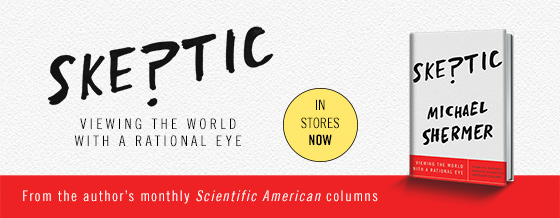
NEW BOOK IN STORES JAN. 12, 2016
Collected essays from bestselling author Michael Shermer’s celebrated columns in Scientific American
For fifteen years, bestselling author Michael Shermer has written a column in Scientific American magazine that synthesizes scientific concepts and theory for a general audience. His trademark combination of deep scientific understanding and entertaining writing style has thrilled his huge and devoted audience for years. Now, in SKE?TIC, seventy-five of these columns are available together for the first time; a welcome addition for his fans and a stimulating introduction for new readers.
Praise for the Book
“Michael Shermer is a beacon of reason in an ocean of irrationality.” —Neil deGrasse Tyson
“Dense with facts, convincing arguments, and curious statistics, this is an ingenious collection of light entertainment for readers who believe that explaining stuff is a good idea.” —Kirkus Reviews
“Shermer makes a strong case for the value of the scientific endeavor and the power of rational thinking in 75 brief essays…. Each entry is insightful, informative, and entertaining.” —Publishers Weekly
“Since those old Scientific American issues have been recycled, revive the popular Shermer’s writings with this collection.” —Booklist

NEW SCIENTIFIC AMERICAN COLUMN ON MICHAELSHERMER.COM
Murder in the Cave: Did Homo naledi behave more like Homo homicidensis?
“Fossil First: Ancient Human Relative May Have Buried Its Dead” (Reuters). “Why Did Homo naledi Bury Its Dead?” (PBS). These are just two of the many hyped headlines that appeared last September in response to a paper purporting the discovery, in a cave in South Africa, of a new species by paleoanthropologist Lee R. Berger of the University of the. There were reasons for skepticism from the get-go.

The age of the fossils is undetermined, so it is impossible to conclude where in the hominin lineage the fossils fit. Their hands, wrists and feet are similar to small modern humans, though slightly modified for an arboreal existence, and their brain volume is closer to that of the small-brained australopithecines, like Lucy, so it is not clear that this combination constitutes a new species or a variation on an existing species. Instead of publishing in a prestigious journal such as Science or Nature, for which the peer-review process can be lengthy, the authors opted for a fast-track publication in eLIFE, an open-access online journal. And instead of meticulously sorting through the 1,550 fossils (belonging to 15 individuals) for many years, as is common in paleoanthropology, the analysis was concluded in a mere year and a half after their discovery in November 2013 and March 2014.*
What triggered my skepticism, however, was the scientists’ conjecture that the site represents the earliest example of “deliberate body disposal,” which, as the media read between the lines, implies an intentional burial procedure. This, they concluded was the likeliest explanation compared with four other hypotheses.
* EDITOR’S NOTE January 11, 2016: On January 7, 2016, Michael Shermer responded to critics of this month’s column, originally published on Scientific American’s website) and on MichaelShermer.com.
FOLLOW MICHAEL SHERMER ON
Twitter • Facebook • Insight • The Moral Arc Blog
![Homo naledi skeletal specimens by Lee Roger Berger research team [CC BY 4.0], via Wikimedia Commons](https://www.skeptic.com/eskeptic/2016/images/16-01-06/Homo_naledi_skeletal_specimens.jpg)
About this week’s feature article
Through random mutation, evolution is relentlessly tinkering—driving species toward diversification. The result is often a wide and bushy family tree that is trimmed and culled by the harshness of natural selection. Could it be that Homo naledi is not a new species at all, but is instead a smaller and more primitive variant of the well known Homo erectus? In this week’s eSkeptic, Nathan H. Lents discusses the recent discovery of Homo naledi, which has created considerable controversy in the world of paleoanthropology.
ABOUT THE PHOTO ABOVE: Homo naledi skeletal specimens by Lee Roger Berger research team [CC BY 4.0], via Wikimedia Commons
Paleoanthropology Wars: The discovery of Homo naledi has generated considerable controversy in this scientific discipline
by Nathan H. Lents
News of the explosive discovery of Homo naledi in South Africa reverberated throughout the world in September 2015. The scientific, popular, and social media were equally abuzz with the truly breathtaking nature of the find: thousands of fossils, more than a dozen individuals, almost an entire skeleton reconstructed. Never in the 150-year history of paleoanthropology had so much been found at once. In one fell swoop, there are now more fossils of H. naledi than there are of more than half of the other named hominins that lived and died over the past seven million years. It was a one-of-a-kind discovery.
The find was different in another way as well. Lee Berger, the anthropologist leading the study, showed a staunch commitment to get the results of the team’s work, and the fossils themselves, out to the public as soon as possible. Within two years of their initial discovery, the first papers were published and the fossils were made available to the public, and not just in the traditional way of publishing a paper and placing precious fossils behind plate glass for the public to gawk at. Berger and another member of the team, John Hawks, completed extensive three-dimensional imaging of the fossils and provided the resulting data free of charge to anyone. With these data, one can 3D print your very own high-resolution casts of the original fossils. From anywhere in the world, one can obtain a facsimile of the highest possible quality, at no cost except for the materials for the printing. Even in our open-access era, this is an unheard of level of transparency and data sharing.
Despite this great excitement, it didn’t take long for some grumblings to be heard. Paleoanthropologist and National Academy of Science member Tim White, for example, stepped forward as the critic-in-chief. White has earned his place in the field’s hall of fame several times over and perhaps his biggest contribution is Ardi (Ardipithecus ramidus), one of the oldest known hominins. Nearly two million years older than “Lucy” (Australopithecus afarensis), Ardi brought deep insight into how and when the lineage that would give rise to humans diverged from our common ancestor with apes.
NEW EPISODE
The God Distraction, Chapter One: Arguments
This is the second video in Mr. Deity’s new series: The God Distraction. If you missed it, watch the introduction. In Chapter One, Mr. Deity asks whether arguments can settle the question of God’s existence.
FOLLOW MR. DEITY
DONATE • PATREON • FACEBOOK • VIMEO • MRDEITY.COM
Paleoanthropology Wars: The discovery of Homo naledi has generated considerable controversy in this scientific discipline
News of the explosive discovery of Homo naledi in South Africa reverberated throughout the world in September 2015. The scientific, popular, and social media were equally abuzz with the truly breathtaking nature of the find: thousands of fossils, more than a dozen individuals, almost an entire skeleton reconstructed. Never in the 150-year history of paleoanthropology had so much been found at once. In one fell swoop, there are now more fossils of H. naledi than there are of more than half of the other named hominins that lived and died over the past seven million years. It was a one-of-a-kind discovery.
The find was different in another way as well. Lee Berger, the anthropologist leading the study, showed a staunch commitment to get the results of the team’s work, and the fossils themselves, out to the public as soon as possible. Within two years of their initial discovery, the first papers were published and the fossils were made available to the public, and not just in the traditional way of publishing a paper and placing precious fossils behind plate glass for the public to gawk at. Berger and another member of the team, John Hawks, completed extensive three-dimensional imaging of the fossils and provided the resulting data free of charge to anyone. With these data, one can 3D print your very own high-resolution casts of the original fossils. From anywhere in the world, one can obtain a facsimile of the highest possible quality, at no cost except for the materials for the printing. Even in our open-access era, this is an unheard of level of transparency and data sharing.
Despite this great excitement, it didn’t take long for some grumblings to be heard. Paleoanthropologist and National Academy of Science member Tim White, for example, stepped forward as the critic-in-chief. White has earned his place in the field’s hall of fame several times over and perhaps his biggest contribution is CONTINUE READING THIS POST…
TAGS: fossil record, Homo erectus, Homo naledi, Ian Tattersall, Lee Berger, paleoanthropology, science, Tim WhiteOnce Upon a Time: Re-Thinking the Fight Against Extremists
What does it mean to be radicalized? In a rare Oval Office address in the wake of the San Bernardino massacre, President Barack Obama described the killers as having “gone down the dark path of radicalization.” It used to be extremists. We were fighting extremists in the equally nebulous War on Terror. Then someone found a thesaurus and now we’re battling radicalization. “[It] is the responsibility of Muslims around the world to root out misguided ideas that lead to radicalization,” urged Obama. What are these ideas exactly?
Every group of radicals nee extremists—from ISIS to the Klan to the House GOP’s Freedom Caucus—all have the same lure: Today is chaotic, unpredictable and worse than it was, so we must return to a time when things were better. A well-proven formula for radicalization is to take the disorientated, disenfranchised and disappointed; add a universal yarn about the Good Ol’ Days and stir.
Let’s examine some backward reasoning about the past: “Back to basics,” you’ll hear. Back to the values of the founders! Original intent! Back to the peacefulness of ancient times. Back to the core of the Koran. Back to the tranquility of our ancestors! Paleo diet, anyone? Fundamentalists use this concept in their own moniker; they’re going back to fundamentals. Even New Agers peddle this idea. The site SacredEarth.com says, “Once upon a time—not too long ago, the ancient craft of midwifery and the art of herbal healing were intimately linked.” Yeah sure, back in the good old days when women had a 50/50 chance of dying during childbirth. Just a quick Google search of “alternative medicine” will land you in a sea of alternate history. As one site touting amber as a pain reliever puts it, “For many centuries since time began, people have used nature’s bounty for traditional medicine.”
Once, I went to the Brooklyn Flea Market and there was a ratty chair kept together by electrical tape. The price tag was a whopping $250! When I asked the seller if that was a typo, he responded CONTINUE READING THIS POST…
TAGS: belief, extremism, faith, Islamism, radicalization, terrorism, violenceeSkeptic for December 30, 2015
In this week’s eSkeptic:
- Annual Fundraiser Call to Action: Please Show Your Support for 2015–2016
- Follow Shermer: In 100 Years, Will People Still Believe in God?
- MonsterTalk: Christmas Special # 3: Pickman’s Model
- Feature: Once Upon a Time: Re-Thinking the Fight Against Extremists
- Science Salon: Watch, for free, our Science Salon from Dec. 20, 2015

ANNUAL FUNDRAISING DRIVE 2015–2016
Show Your Support for the Work of the Skeptics Society and Download a Free PDF of The Top 10 Strangest Beliefs We’ve Encountered
Ever since Michael Shermer wrote Why People Believe Weird Things he has been asked to list the strangest beliefs he’s come across in his quarter century as a professional skeptic. Naturally the criteria of what constitutes “weird” is necessarily subjective, so he considered not just the error of the belief but the wider impact the belief has on society.
As we count down to the new year, we have compiled this list into The Top 10 Weirdest Things Countdown—a printable PDF that you may download for free and share it in this format, as our gift to you, to thank you for your ongoing support during our Annual Fundraising Drive for 2015–2016.
We cannot continue to do what we do without your generous financial support.
Donate Online or Call 1-626-794-3119
Help your Skeptics Society—a 501(c)(3) nonprofit educational organization—to promote science and critical thinking. You can make a tax-deductible donation online using your credit card, or by downloading a printable donation card to make your donation by cheque. You may also make a donation by calling 1-626-794-3119. All donations are tax deductible.

MICHAEL SHERMER ON BIGTHINK.COM
In 100 Years, Will People Still Believe in God?
One day, people will look back on humanity’s religious past and laugh, says skeptic and science writer Michael Shermer, in this video, recorded for Big Think. Read more from Michael on this topic on BigThink.com: “Weaning People off Religious Belief Is a Sales and Marketing Problem.”
FOLLOW MICHAEL SHERMER ON
Twitter • Facebook • Insight • The Moral Arc Blog
Pickman’s Model
MonsterTalk Christmas Special # 3
In this MonsterTalk Christmas Special episode, Blake Smith reads aloud Pickman’s Model, a story by H.P. Lovecraft and gives a brief update about the MonsterTalk podcast.
Get the MonsterTalk Podcast App and enjoy the science show about monsters on your handheld devices! Available for iOS, Android, and Windows 8 devices. Subscribe to MonsterTalk for free on iTunes. Follow the RSS feed.
About this week’s eSkeptic
What does it mean to be radicalized? Why can’t we wage a war on extremists? Why can’t we just embrace the moderates to counter extremists? In this week’s eSkeptic, investigative journalist Tina Dupuy proposes the need to re-think the fight against extremists as she examines some backward reasoning about our innate desire to get back to paradise.
Tina Dupuy is a syndicated columnist and investigative journalist. She’s the host of Cultish, a new podcast about fanaticism debuting in February 2016. She lives in New York.
Once Upon a Time: Re-Thinking the Fight Against Extremists
by Tina Dupuy
What does it mean to be radicalized? In a rare Oval Office address in the wake of the San Bernardino massacre, President Barack Obama described the killers as having “gone down the dark path of radicalization.” It used to be extremists. We were fighting extremists in the equally nebulous War on Terror. Then someone found a thesaurus and now we’re battling radicalization. “[It] is the responsibility of Muslims around the world to root out misguided ideas that lead to radicalization,” urged Obama. What are these ideas exactly?
Every group of radicals nee extremists—from ISIS to the Klan to the House GOP’s Freedom Caucus—all have the same lure: Today is chaotic, unpredictable and worse than it was, so we must return to a time when things were better. A well-proven formula for radicalization is to take the disorientated, disenfranchised and disappointed; add a universal yarn about the Good Ol’ Days and stir.
Let’s examine some backward reasoning about the past: “Back to basics,” you’ll hear. Back to the values of the founders! Original intent! Back to the peacefulness of ancient times. Back to the core of the Koran. Back to the tranquility of our ancestors! Paleo diet, anyone? Fundamentalists use this concept in their own moniker; they’re going back to fundamentals. Even New Agers peddle this idea. The site SacredEarth.com says, “Once upon a time—not too long ago, the ancient craft of midwifery and the art of herbal healing were intimately linked.” Yeah sure, back in the good old days when women had a 50/50 chance of dying during childbirth. Just a quick Google search of “alternative medicine” will land you in a sea of alternate history. As one site touting amber as a pain reliever puts it, “For many centuries since time began, people have used nature’s bounty for traditional medicine.”
Once, I went to the Brooklyn Flea Market and there was a ratty chair kept together by electrical tape. The price tag was a whopping $250! When I asked the seller if that was a typo, he responded “No,” shocked by the question. “It’s old.” Which is essentially what alternative medicine is saying. “Back when people only lived to 35, they knew better than us!” […]
WATCH THE RECORDING FOR FREE
The Science Salon on Richard Feynman, featuring Michelle Feynman, Leonard Mlodinow, & Seamus Blackley in Conversation with Michael Shermer
If you missed this Science Salon, you can now watch it for free. Michelle Feynman discusses the life and legacy of her father: Nobel prize-winning physicist Richard P. Feynman.
The Top 10 Weirdest Things
Ever since Michael Shermer wrote Why People Believe Weird Things he has been asked to list the strangest beliefs he’s come across in his quarter century as a professional skeptic. Naturally the criteria of what constitutes “weird” is necessarily subjective, so he considered not just the error of the belief but the wider impact the belief has on society.
As we count down to the new year, we have compiled this list into The Top 10 Weirdest Things Countdown—a printable PDF that you may download for free and share it in this format, as our gift to you, to thank you for your ongoing support during our Annual Fundraising Drive for 2015–2016. CONTINUE READING THIS POST…
TAGS: 9/11 conspiracy theories, afterlife, Ancient Aliens, belief, creationism, end of the world, free download, God, holocaust denial, Intelligent Design, JFK conspiracy theories, morphic resonance, soul, UFOsMerry Kitzmas! The 10th Anniversary of the Dover Decision and the Demise of Intelligent Design
Sunday, December 20, marked the 10th anniversary of Judge John Jones’ decision in the landmark Kitzmiller vs. Dover Area School District case, better known as the court case that finally put intelligent design (ID) creationism on trial. The case began in 2004 when creationists on the Dover, Pennsylvania, school board tried to sneak intelligent design creationist material from the Discovery Institute in Seattle into the school curriculum. The science teachers rebelled, as did a number of parents who became plaintiffs in the case. It was finally brought to trial on Sept. 26, 2005, and the trial lasted 40 days and 40 nights before the judge received the case for his deliberation.
During the course of the trial, the witnesses for intelligent design creationism were repeatedly exposed for their bad science, and the documents that were introduced show the clear imprint of having been recycled from older creationist documents. The most striking evidence of this was the discovery of different editions of the textbook Of Pandas and People. Early drafts were full of conventional creationism, but when a federal case struck down young-earth creationism for the final time, the authors just cut and paste a few phrases here and there to remove the references to “God”, “creation”, and “creationism”. In one place, the plaintiffs’ legal team exposed a telltale palimpsest: the phrase “cdesign proponentsists”, where the phrase “design proponents” has been clumsily and incompletely pasted over the word “creationists”.
The plaintiffs’ attorneys also brought together a stellar cast of scientists and philosophers and teachers, all of whom clearly showed that intelligent design creationism was just the religious dogma of creationism disguised with the obvious references to God removed. The most damaging testimony, however, came from creationist school board members Bill Buckingham and Alan Bonsell, who were confronted with the many statements they had made in the past where they clearly stated CONTINUE READING THIS POST…
TAGS: Dover, evolution, Intelligent Design Creationism, Kitzmiller
